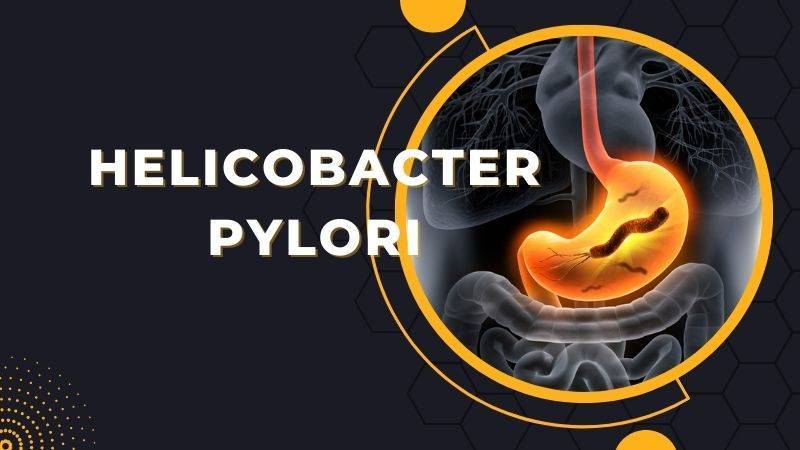Highlights
Helicobacter Pylori (H. Pylori) is a bacteria species that has gathered substantial attention in the medical community due to its widespread prevalence and significant health implications.
It is believed that about half of the global population is infected with H. Pylori, yet a large portion remains asymptomatic.
The persistent nature of this bacterium and its role in various diseases makes understanding it crucial for global health.
This article provides an in-depth look at H. Pylori, its impact on human health, and the latest advances in diagnosis and treatment.
What is H.Pylori?

H. Pylori is a gram-negative, spiral-shaped bacterium found primarily in the stomach.
It was identified by Australian scientists Barry Marshall and Robin Warren in 1982, who went on to receive a Nobel Prize for their work.
Their discovery upended the prevailing belief that bacteria couldn’t survive in the stomach’s acidic environment.
The bacterium’s unique spiral shape and flagella help it burrow into the stomach’s mucus lining, where it converts the abundant urea into ammonia to neutralize stomach acids.
These adaptations allow H. Pylori to survive and proliferate within the hostile gastric environment.
H. Pylori’s Role in Disease

While many H. Pylori carriers are asymptomatic, the bacterium’s presence is linked with a range of gastrointestinal diseases.
These include
- Gastritis (inflammation of the stomach lining)
- Peptic ulcers (sores in the stomach lining)
- Gastric cancer, the third most common cause of cancer-related death globally.
H. Pylori is implicated in more than 90% of duodenal ulcers and up to 80% of gastric ulcers.
Additionally, chronic H. Pylori infection increases the risk of gastric adenocarcinoma and mucosa-associated lymphoid tissue (MALT) lymphoma.
Symptoms
Most people with H. pylori don’t feel sick at all. But these bacteria can harm the inside lining of your stomach and may lead to other illnesses, like stomach ulcers.
If you get a stomach ulcer from H. pylori, you might feel:
- A dull or burning pain in your stomach (this can be worse when your stomach is empty)
- Your stomach might feel bloated
- You might feel like throwing up
- You might lose weight without trying
- You might throw up
- You might burp a lot
- You might not feel like eating
Though it’s not common, people with H. pylori are also at a higher risk for stomach cancer.
If you have stomach cancer, you might feel:
- Not much hunger
- Lose weight without trying
- Notice blood in your poop
- Feel like throwing up
- Feel full quickly when eating
- Discomfort or bloating in your tummy
- Stomach pain
- Feel tired or weak
However, many of these signs can also be caused by other health problems. If you feel something that worries you, you should talk to a doctor.
Also, if you have trouble swallowing, anemia, see blood in your poop, or your poop or vomit is black, you should get help from a doctor right away.
Causes And Risk Factors
We’re not exactly sure how H. pylori infections pass from person to person. We’ve been living with these bacteria for a very long time.
It’s believed that the bacteria might move from one person to another through contact with vomit or poop.
This could happen if someone doesn’t wash their hands well after using the bathroom.
H. pylori can also spread if you touch or eat food or drink water that has the bacteria on it.
Risk Factors
Kids are more likely to get an H. pylori infection. This is mostly because kids might not always keep themselves clean.
Where you live and how you live can also affect your chance of getting an H. pylori infection. You have a higher risk if you:
- Live in a country that doesn’t have a lot of resources
- Don’t have clean water to use
- Live with other people who have H. pylori
- Live in a place that’s really crowded
Diagnosis

H. Pylori infection can be diagnosed using various methods:
Breath Test: This non-invasive test involves the patient ingesting a urea-containing substance. If H. Pylori is present, the bacteria will metabolize the urea into carbon dioxide, which can be detected in the breath.
Blood Test: This test checks for antibodies to H. Pylori, indicating a past or current infection. However, it may not be useful in determining active infection.
Stool Antigen Test: This test detects H. Pylori antigen in stool samples, indicating an active infection.
Endoscopy: An invasive procedure that allows a direct look at the stomach lining and collection of biopsy samples for testing.
Treatment
If you don’t feel sick, you don’t need treatment. If a test shows you have H. pylori, you should not take drugs called nonsteroidal anti-inflammatory drugs. These drugs can make you more likely to get an ulcer.
Ulcers caused by H. pylori are treated with a mix of antibiotics and a medicine that lowers acid called a proton pump inhibitor.
Antibiotics
Doctors usually prescribe two antibiotics. Some common choices are
- Amoxicillin
- Clarithromycin (Biaxin®)
- Metronidazole (Flagyl®)
- Tetracycline
Proton pump inhibitor
Some proton pump inhibitors that are often used include
- Lansoprazole (Prevacid®)
- Omeprazole (Prilosec®)
- Pantoprazole (Protonix®)
- Rabeprazole (Aciphex®)
- Esomeprazole (Nexium®)
Bismuth Subsalicylate
Sometimes, this medicine (like Pepto-Bismol®) is added to the antibiotics and proton pump inhibitor combo mentioned above.
This medicine helps protect the lining of your stomach. You usually need to take this combination of medicines for 14 days.
There’s a new medicine called Talicia® that combines two antibiotics (rifabutin and amoxicillin) with a proton pump inhibitor (omeprazole) all in one pill.
Prevention
There isn’t a vaccine that can stop you from getting H. pylori. But, being healthy and clean can help keep you from getting infected.
You can lower your chances of getting H. pylori by:
- Washing your hands a lot, especially before you cook or eat, or after you use the bathroom
- Drinking water that you know is clean
- Not eating food that hasn’t been cleaned right or cooked safely
Link Between H. Pylori Infection and Stomach Cancer
If you have H. pylori, you’re more likely to get stomach cancer when you’re older.
If a lot of people in your family have had stomach cancer and you have other things that make you more likely to get cancer, your doctor might want to test you for H. pylori, even if you don’t feel sick.
Besides getting tested and treated, your doctor might also tell you to eat more fruits, veggies, and fiber.
Going to regular check-ups with your doctor and doing what they recommend can lower your chances of getting cancer.
Confirming the Cure of H. Pylori Infection
To check if the H. pylori infection is gone, your doctor will do a breath or poop test.
This test is done at least two weeks after you’ve finished the medicine that lowers stomach acid and four weeks after you’ve finished the antibiotic medicine.
Conclusion
Even though we found out about H. pylori over 40 years ago, it’s still a big cause of sickness around the world.
The fact that these bacteria are getting harder to kill with antibiotics means we need to keep a closer eye on them, find better ways to treat them, and keep learning more about them.
It’s really important to understand how these bacteria live and survive, and how they make people sick, so we can lessen the harm they cause to our health.
Take Care of Yourself!






